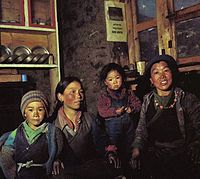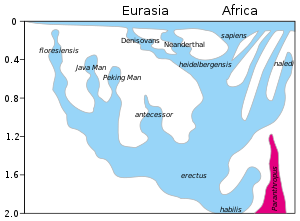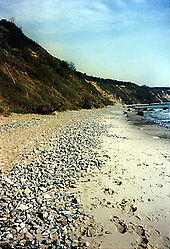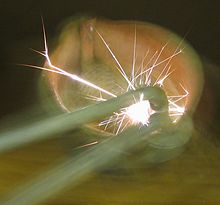While the rest of the human population would suffer serious
health consequences, the indigenous inhabitants of these regions thrive
well in the highest parts of the world. These people have undergone
extensive physiological and genetic changes, particularly in the
regulatory systems of oxygen respiration and blood circulation, when compared to the general lowland population.
This special adaptation is now recognised as an example of natural selection in action. The adaptation account of the Tibetans has become the fastest case of human evolution in the scientific record, as it is estimated to have occurred in less than 3,000 years.
Modern humans dispersed from Africa less than 100,000 years ago, and eventually colonized the rest of the world, including the harshest environments of extreme cold and high mountains. The abundance of oxygen in the atmosphere is inversely related to altitude from the sea level; hence, the highest mountain ranges of the world are considered unsuitable for human habitation.
Nevertheless, around 140 million people, just under 2% of the world's human population, live permanently at high altitudes, that is, at heights above 2,500 metres (8,200 ft) in South America, East Africa, and South Asia. These populations have done so for millennia without apparent complications. The overwhelming majority, over 98% of humans from other parts of the world, normally suffer symptoms of altitude sickness in these regions, often resulting in life-threatening trauma and even death.
Studies on the detail biological mechanism have revealed that adaptation of the Tibetans, Andeans and Ethiopians is indeed an observable instance of the process of natural selection in acting on favourable characters such as enhanced respiratory mechanisms in humans.
This special adaptation is now recognised as an example of natural selection in action. The adaptation account of the Tibetans has become the fastest case of human evolution in the scientific record, as it is estimated to have occurred in less than 3,000 years.
Modern humans dispersed from Africa less than 100,000 years ago, and eventually colonized the rest of the world, including the harshest environments of extreme cold and high mountains. The abundance of oxygen in the atmosphere is inversely related to altitude from the sea level; hence, the highest mountain ranges of the world are considered unsuitable for human habitation.
Nevertheless, around 140 million people, just under 2% of the world's human population, live permanently at high altitudes, that is, at heights above 2,500 metres (8,200 ft) in South America, East Africa, and South Asia. These populations have done so for millennia without apparent complications. The overwhelming majority, over 98% of humans from other parts of the world, normally suffer symptoms of altitude sickness in these regions, often resulting in life-threatening trauma and even death.
Studies on the detail biological mechanism have revealed that adaptation of the Tibetans, Andeans and Ethiopians is indeed an observable instance of the process of natural selection in acting on favourable characters such as enhanced respiratory mechanisms in humans.
Origin and basis
Himalayas, on the southern rim of the Tibetan Plateau
Humans are naturally adapted to lowland environment where oxygen is abundant. When people from the general lowlands go to altitudes above 2,500 metres (8,200 ft), with atmospheric pressure 74% of normal they experience mountain sickness, which is a type of hypoxia, a clinical syndrome of severe lack of oxygen. Complications include fatigue, dizziness, breathlessness, headaches, insomnia, malaise, nausea, vomiting, body pain, loss of appetite, ear-ringing, blistering and purpling of the hands and feet, and dilated veins.
The sickness is compounded by related symptoms such as cerebral oedema (swelling of brain) and pulmonary oedema (fluid accumulation in lungs). For several days, they breathe excessively and burn extra energy even when the body is relaxed. The heart rate then gradually decreases. Hypoxia, in fact, is one of the principal causes of death among mountaineers. In women, pregnancy can be severely affected, such as development of high blood pressure, called preeclampsia, which causes premature labour, low birth weight of babies, and often complicated with profuse bleeding, seizures, and death of the mother.
More than 140 million people worldwide are estimated to live at
an elevation higher than 2,500 metres (8,200 ft) above sea level, of
which 13 million are in Ethiopia, 1.7 million in Tibet (total of 78
million in Asia), 35 million in the South American Andes, and 0.3 million in Colorado Rocky Mountains.
Certain natives of Tibet, Ethiopia, and the Andes have been living at
these high altitudes for generations and are protected from hypoxia as a
consequence of genetic adaptation. It is estimated that at 4,000 metres (13,000 ft), every lungful of air only has 60% of the oxygen molecules that people at sea level have. At elevations above 7,600 metres (24,900 ft), lack of oxygen
becomes seriously lethal. That is, these highlanders are constantly
exposed to an intolerably low oxygen environment, yet they live without
any debilitating problems. Basically, the shared adaptation is the ability to maintain relatively low levels of haemoglobin, which is the chemical complex for transporting oxygen in the blood. One of the best documented effects of high altitude is a progressive reduction in birth weight.
It has been known that women of long-resident high-altitude population
are not affected. These women are known to give birth to heavier-weight
infants than women of lowland inhabitants. This is particularly true
among Tibetan babies, whose average birth weight is 294-650 (~470) g
heavier than the surrounding Chinese population; and their blood-oxygen level is considerably higher.
The first scientific investigations of high-altitude adaptation was done by A. Roberto Frisancho of the University of Michigan in the late 1960s among the Quechua people of Peru. Paul T. Baker, Penn State University, (in the Department of Anthropology)
also conducted a considerable amount of research into human adaptation
to high altitudes, and mentored students who continued this research.
One of these students went on to conduct research on high altitude
adaptation among the Tibetans in the early 1980s through to today,
anthropologist Cynthia Beall of the Case Western Reserve University.
Physiological basis
Tibetans
A Sherpa family
Scientists started to notice the extraordinary physical performance
of Tibetans since the beginning of Himalayan climbing era in the early
20th century. The hypothesis of a possible evolutionary genetic
adaptation makes sense. The Tibetan plateau
has an average elevation of 4,000 metres (13,000 ft) above sea level,
and covering more than 2.5 million km, it is the highest and largest plateau
in the world. In 1990, it was estimated that 4,594,188 Tibetans live on
the plateau, with 53% living at an altitude over 3,500 metres
(11,500 ft). Fairly large numbers (about 600,000) live at an altitude
exceeding 4,500 metres (14,800 ft) in the Chantong-Qingnan area.
Where the Tibetan highlanders live, the oxygen level is only about 60%
of that at sea level. The Tibetans, who have been living in this region
for 3,000 years, do not exhibit the elevated haemoglobin concentrations
to cope with oxygen deficiency as observed in other populations who have
moved temporarily or permanently at high altitudes. Instead, the
Tibetans inhale more air with each breath and breathe more rapidly than
either sea-level populations or Andeans. Tibetans have better oxygenation at birth, enlarged lung volumes throughout life, and a higher capacity for exercise. They show a sustained increase in cerebral blood flow, lower haemoglobin concentration, and less susceptibility to chronic mountain sickness than other populations, due to their longer history of high-altitude habitation.
General people can develop short-term tolerance with careful
physical preparation and systematic monitoring of movements, but the
biological changes are quite temporary and reversible when they return
to lowlands. Moreover, unlike lowland people who only experience increased breathing
for a few days after entering high altitudes, Tibetans retain this
rapid breathing and elevated lung-capacity throughout their lifetime.
This enables them to inhale larger amounts of air per unit of time to
compensate for low oxygen levels. In addition, they have high levels
(mostly double) of nitric oxide in their blood, when compared to lowlanders, and this probably helps their blood vessels dilate for enhanced blood circulation. Further, their haemoglobin level is not significantly different (average 15.6 g/dl in males and 14.2 g/dl in females),
from those of people living at low altitude. (Normally, mountaineers
experience >2 g/dl increase in Hb level at Mt. Everest base camp in
two weeks.)
In this way they are able to evade both the effects of hypoxia and
mountain sickness throughout life. Even when they climbed the highest
summits like Mt. Everest, they showed regular oxygen uptake, greater
ventilation, more brisk hypoxic ventilatory responses, larger lung
volumes, greater diffusing capacities, constant body weight and a better
quality of sleep, compared to people from the lowland.
Andeans
In
contrast to the Tibetans, the Andean highlanders, who have been living
at high-altitudes for no more than 11,000 years, show different pattern
of haemoglobin adaptation. Their haemoglobin concentration is higher
compared to those of lowlander population, which also happens to
lowlanders moving to high altitude. When they spend some weeks in the
lowland their haemoglobin drops to average of other people. This shows
only temporary and reversible acclimatisation. However, in contrast to
lowland people, they do have increased oxygen level in their
haemoglobin, that is, more oxygen per blood volume than other people.
This confers an ability to carry more oxygen in each red blood cell,
making a more effective transport of oxygen in their body, while their
breathing is essentially at the same rate.
This enables them to overcome hypoxia and normally reproduce without
risk of death for the mother or baby. The Andean highlanders are known
from the 16th-century missionaries that their reproduction had always
been normal, without any effect in the giving birth or the risk for early pregnancy loss, which are common to hypoxic stress. They have developmentally acquired enlarged residual lung volume and its associated increase in alveolar area, which are supplemented with increased tissue thickness and moderate increase in red blood cells. Though the physical growth in body size is delayed, growth in lung volumes is accelerated. An incomplete adaptation such as elevated haemoglobin levels still leaves them at risk for mountain sickness with old age.
Quechua woman with llamas
Among the Quechua people of the Altiplano, there is a significant variation in NOS3 (the gene encoding endothelial nitric oxide synthase, eNOS), which is associated with higher levels of nitric oxide in high altitude.
Nuñoa children of Quechua ancestry exhibit higher blood-oxygen content
(91.3) and lower heart rate (84.8) than their counterpart school
children of different ethnicity, who have an average of 89.9
blood-oxygen and 88-91 heart rate. High-altitude born and bred females of Quechua origins have comparatively enlarged lung volume for increased respiration.
Aymara ceremony
Blood profile comparisons show that among the Andeans, Aymaran highlanders are better adapted to highlands than the Quechuas. Among the Bolivian
Aymara people, the resting ventilation and hypoxic ventilatory response
were quite low (roughly 1.5 times lower), in contrast to those of the
Tibetans. The intrapopulation genetic variation was relatively less
among the Aymara people.
Moreover, unlike the Tibetans, the blood haemoglobin level is quite
normal among Aymarans, with an average of 19.2 g/dl for males and
17.8 g/dl for females.
Among the different native highlander populations, the underlying
physiological responses to adaptation are quite different. For example,
among four quantitative features, such as are resting ventilation,
hypoxic ventilatory response, oxygen saturation, and haemoglobin
concentration, the levels of variations are significantly different
between the Tibetans and the Aymaras.
Ethiopians
The peoples of the Ethiopian highlands
also live at extremely high altitudes, around 3,000 metres (9,800 ft)
to 3,500 metres (11,500 ft). Highland Ethiopians exhibit elevated
haemoglobin levels, like Andeans and lowlander peoples at high
altitudes, but do not exhibit the Andean’s increased in oxygen-content
of haemoglobin.
Among healthy individuals, the average haemoglobin concentrations are
15.9 and 15.0 g/dl for males and females respectively (which is lower
than normal, almost similar to the Tibetans), and an average oxygen
saturation of haemoglobin is 95.3% (which is higher than average, like
the Andeans).
Additionally, Ethiopian highlanders do not exhibit any significant
change in blood circulation of the brain, which has been observed among
the Peruvian highlanders (and attributed to their frequent
altitude-related illnesses).
Yet, similar to the Andeans and Tibetans, the Ethiopian highlanders are
immune to the extreme dangers posed by high-altitude environment, and
their pattern of adaptation is definitely unique from that of other
highland peoples.
Genetic basis
The underlying molecular evolution of high-altitude adaptation has been explored and understood fairly recently.
Depending on the geographical and environmental pressures,
high-altitude adaptation involves different genetic patterns, some of
which
have evolved quite recently. For example, Tibetan adaptations became
prevalent in the past 3,000 years, a rapid example of recent human evolution.
At the turn of the 21st century, it was reported that the genetic
make-up of the respiratory components of the Tibetan and the Ethiopian
populations are significantly different.
Tibetans
Substantial evidence in Tibetan highlanders suggests that variation in haemoglobin and blood-oxygen levels are adaptive as Darwinian fitness. It has been documented that Tibetan women with a high likelihood of possessing one to two alleles
for high blood-oxygen content (which is odd for normal women) had more
surviving children; the higher the oxygen capacity, the lower the infant
mortality.
In 2010, for the first time, the genes responsible for the unique
adaptive traits were identified following genome sequences of 50
Tibetans and 40 Han Chinese from Beijing.
Initially, the strongest signal of natural selection detected was a
transcription factor involved in response to hypoxia, called endothelial
Per-Arnt-Sim (PAS) domain protein 1 (EPAS1). It was found that one single-nucleotide polymorphism (SNP) at EPAS1
shows a 78% frequency difference between Tibetan and mainland Chinese
samples, representing the fastest genetic change observed in any human
gene to date. Hence, Tibetan adaptation to high altitude becomes the
fastest process of phenotypically observable evolution in humans, which is estimated to occur in less than 3,000 years ago, when the Tibetans split up from the mainland Chinese population. Mutations in EPAS1,
at higher frequency in Tibetans than their Han neighbours, correlate
with decreased haemoglobin concentrations among the Tibetans, which is
the hallmark of their adaptation to hypoxia. Simultaneously, two genes,
egl nine homolog 1 (EGLN1) (which inhibits haemoglobin production under high oxygen concentration) and peroxisome proliferator-activated receptor alpha (PPARA), were also identified to be positively selected in relation to decreased haemoglobin nature in the Tibetans.
Similarly, the Sherpas, known for their Himalayan hardiness, exhibit similar patterns in the EPAS1 gene, which further fortifies that the gene is under selection for adaptation to the high-altitude life of Tibetans. A study in 2014 indicates that the mutant EPAS1 gene could have been inherited from archaic hominins, the Denisovans. EPAS1 and EGLN1 are definitely the major genes for unique adaptive traits when compared with those of the Chinese and Japanese.
Comparative genome analysis in 2014 revealed that the Tibetans
inherited an equal mixture of genomes from the Nepalese-Sherpas and
Hans, and they acquired the adaptive genes from the sherpa-lineage.
Further, the population split was estimated to occur around 20,000 to
40,000 years ago, a range of which support archaeological, mitochondria
DNA and Y chromosome evidence for an initial colonisation of the Tibetan
plateau around 30,000 years ago.
The genes (EPAS1, EGLN1, and PPARA) function in concert with another gene named hypoxia inducible factors (HIF), which in turn is a principal regulator of red blood cell production (erythropoiesis) in response to oxygen metabolism. The genes are associated not only with decreased haemoglobin levels, but also in regulating energy metabolism. EPAS1 is significantly associated with increased lactate concentration (the product of anaerobic glycolysis), and PPARA is correlated with decrease in the activity of fatty acid oxidation. EGLN1 codes for an enzyme, prolyl hydroxylase 2 (PHD2), involved in erythropoiesis. Among the Tibetans, mutation in EGLN1
(specifically at position 12, where cytosine is replaced with guanine;
and at 380, where G is replaced with C) results in mutant PHD2 (aspartic
acid at position 4 becomes glutamine, and cysteine at 127 becomes
serine) and this mutation inhibits erythropoiesis. The mutation is
estimated to occur about 8,000 years ago. Further, the Tibetans are enriched for genes in the disease class of human reproduction (such as genes from the DAZ, BPY2, CDY, and HLA-DQ and HLA-DR gene clusters) and biological process categories of response to DNA damage stimulus and DNA repair (such as RAD51, RAD52, and MRE11A), which are related to the adaptive traits of high infant birth weight and darker skin tone and are most likely due to recent local adaptation.
Andeans
The
patterns of genetic adaptation among the Andeans are largely distinct
from those of the Tibetan, with both populations showing evidence of
positive natural selection in different genes or gene regions. However, EGLN1
appears to be the principal signature of evolution, as it shows
evidence of positive selection in both Tibetans and Andeans. Even then,
the pattern of variation for this gene differs between the two
populations. Among the Andeans, there are no significant associations between EPAS1 or EGLN1 SNP genotypes and haemoglobin concentration, which has been the characteristic of the Tibetans.
The whole genome sequences of 20 Andeans (half of them having chronic
mountain sickness) revealed that two genes, SENP1 (an erythropoiesis
regulator) and ANP32D (an oncogene) play vital roles in their weak
adaptation to hypoxia.
Ethiopians
The
adaptive mechanism of Ethiopian highlanders is quite different. This is
probably because their migration to the highland was relatively early;
for example, the Amhara
have inhabited altitudes above 2,500 metres (8,200 ft) for at least
5,000 years and altitudes around 2,000 metres (6,600 ft) to 2,400 metres
(7,900 ft) for more than 70,000 years. Genomic analysis of two ethnic groups, Amhara and Oromo, revealed that gene variations associated with haemoglobin difference among Tibetans or other variants at the same gene location do not influence the adaptation in Ethiopians. Identification of specific genes further reveals that several candidate genes are involved in Ethiopians, including CBARA1, VAV3, ARNT2 and THRB. Two of these genes (THRB and ARNT2) are known to play a role in the HIF-1 pathway,
a pathway implicated in previous work reported in Tibetan and Andean
studies. This supports the concept that adaptation to high altitude
arose independently among different highlanders as a result of convergent evolution.














